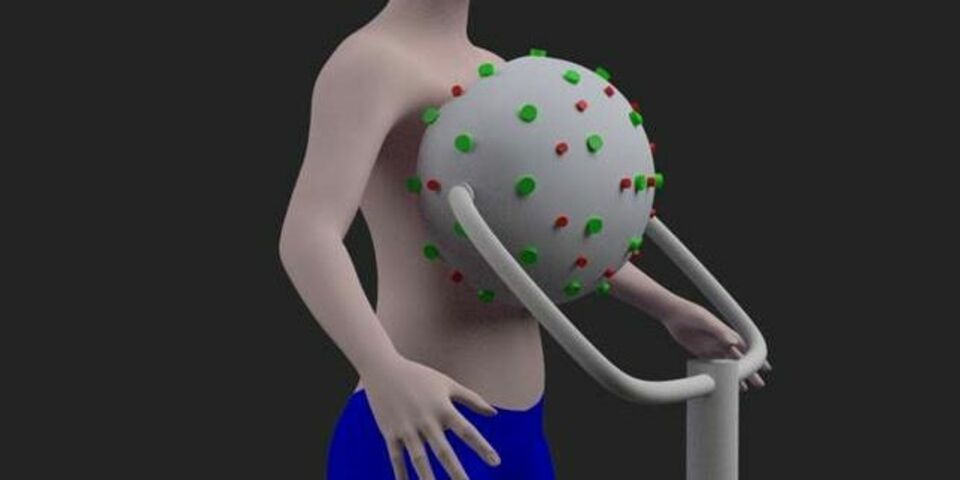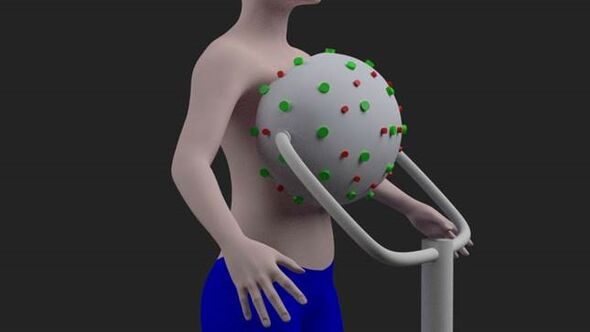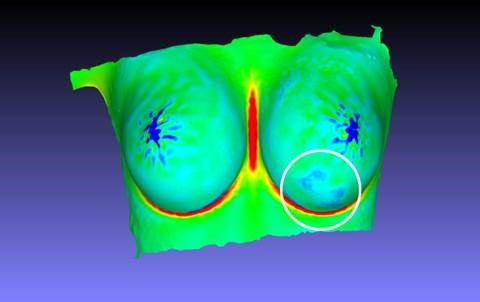Detecting breast cancer using 3D photography
The national screening program for breast cancer is only for women aged between fifty and seventy-five and can be painful. The Early Warning Scan may provide a contactless alternative that is also suitable for younger women. TU/e is involved in developing this scanner, based on 3D-photography, via two routes: the Jheronimus Academy of Data Science and employee Moniek Sanders. In her role as official secretary of the YvYa Foundation, she is helping to get this invention, the work of her brother Tom, off the ground.
There's a personal story behind the concept for the Early Warning Scan, relates Moniek Sanders. “My sister-in-law Paulette Kreté learned she had breast cancer in early 2019. The tumor was quite large, but atypical, which had prevented its detection in the breast cancer screening program. Fortunately, her treatment for the tumor was successful: a year later the tumor was gone.”
The fact that his wife's tumor was not picked up in the population study, however, gave Moniek's brother Tom Sanders an idea. “He is an expert in the field of 3D color photography and his immediate response was to conceive the concept for a breast scanner based on this technology.”
Charity
The attending oncology surgeon at the Catharina Hospital was, she says, immediately enthusiastic and as early as the fall of 2019 Holland High Tech awarded a 'seed funding grant' of 25,000 euros so that the idea's feasibility could be explored with the Jheronimus Academy of Data Science (JADS) - a collaboration between TU/e and Tilburg University.
“That part of the project has since been completed,” tells Moniek Sanders. “But to become eligible for research funding, you need a prototype. And so we decided to collect money through a foundation, which we named YvYa, for fellow patients Yvonne and Hülya whom my sister-in-law got to know in the hospital.” Moniek, who works as a secretary at the TU/e department Built Environment, became the foundation's official secretary and on May 1st of this year the foundation was officially recognized as a charity.
Now, with funds provided by collection campaigns, and drawing on the findings of the JADS report, technology company Demcon in Best is building a prototype of the Early Warning Scan. The images taken by fifty small photographic cameras are combined to create a 3D image of the breast. In contrast to current scanners, which require each breast in turn to be flattened between two glass plates in preparation for an X-ray, the Early Warning Scan is contactless.
The thinking is that from a series of 3D recordings of the exterior of the breast in movement - the woman stands on a vibrating plate during the scan - information can be gained about the structure of the breast tissue. With the aid of artificial intelligence, it should be possible to detect suspicious differences in movement - which may indicate a tumor - between a new scan and an earlier one.
Young women
In addition, it is hoped that this technology will also be suitable for detecting relevant abnormalities in younger women. In today's mammograms, the gland tissue in young breasts usually make tumors invisible. For this reason - and because breast cancer is much more prevalent in women over the age of fifty - young women are currently not included in the national breast cancer screening program.
But given that one in seven women will at some time in her life develop breast cancer, it is a diagnosis that a good many young women receive. Among them the Yvonne who lent her name to the foundation. She died of the disease aged thirty-seven, leaving behind a husband and two young sons. Because it is important to discover any tumor as early as possible, the Early Warning Scan, provided it becomes a success, therefore has the potential to prevent a great deal of suffering.
JADS
This is also confirmed by researcher Daan Kolkman, who in his capacity for JADS has led the seeding project related to the Early Warning Scan for the past eighteen months. “Any new concept has a good risk of failing but if it is successful, it is very valuable.“ The conclusion of the study, due to the corona pandemic based purely on computer simulations, is that in principle it should indeed be possible to detect breast cancer using a combination of 3D photography and artificial intelligence.
The work carried out by JADS includes looking at the best way of converting the fifty 2D photographs into a 3D image of the breast. “In principle, Tom Sanders' concept makes use of existing commercial software,” Kolkman explains. “But as a result a single 3D reconstruction can easily take forty minutes; depending on the resolution required, a good estimate of which we don't yet have. This could well be too slow for use in practice.”
For this reason, Kolkman arranged via the JADS MKB Datalab for the Brazilian student Camilla Matoba to study which faster open source algorithms based on artificial intelligence may be suitable for this particular application. She concluded last week that with a certain algorithm using neural networks a considerable time-saving can be made. Basically, the computation time needs to be proportionate to the other steps in the scanning process, Kolkman emphasizes. “By comparison, if you have an MRI scan, you don't get the results immediately either.”
Preclinical tests
The new prototype of the Early Warning Scan is expected to be delivered by Demcon before the end of the summer. So that it can be put through preclinical tests at the Catharina Cancer Institute, a grant proposal has been submitted to KWF. Scientific research will continue to be necessary in the next phase in order that the effectiveness of the Early Warning Scan can be validated, Moniek Sanders is keen to point out. Any help lent by TU/e at that stage would be very welcome. “We'd embrace the opportunity to collaborate with TU/e on further technical scientific development.”




Discussion